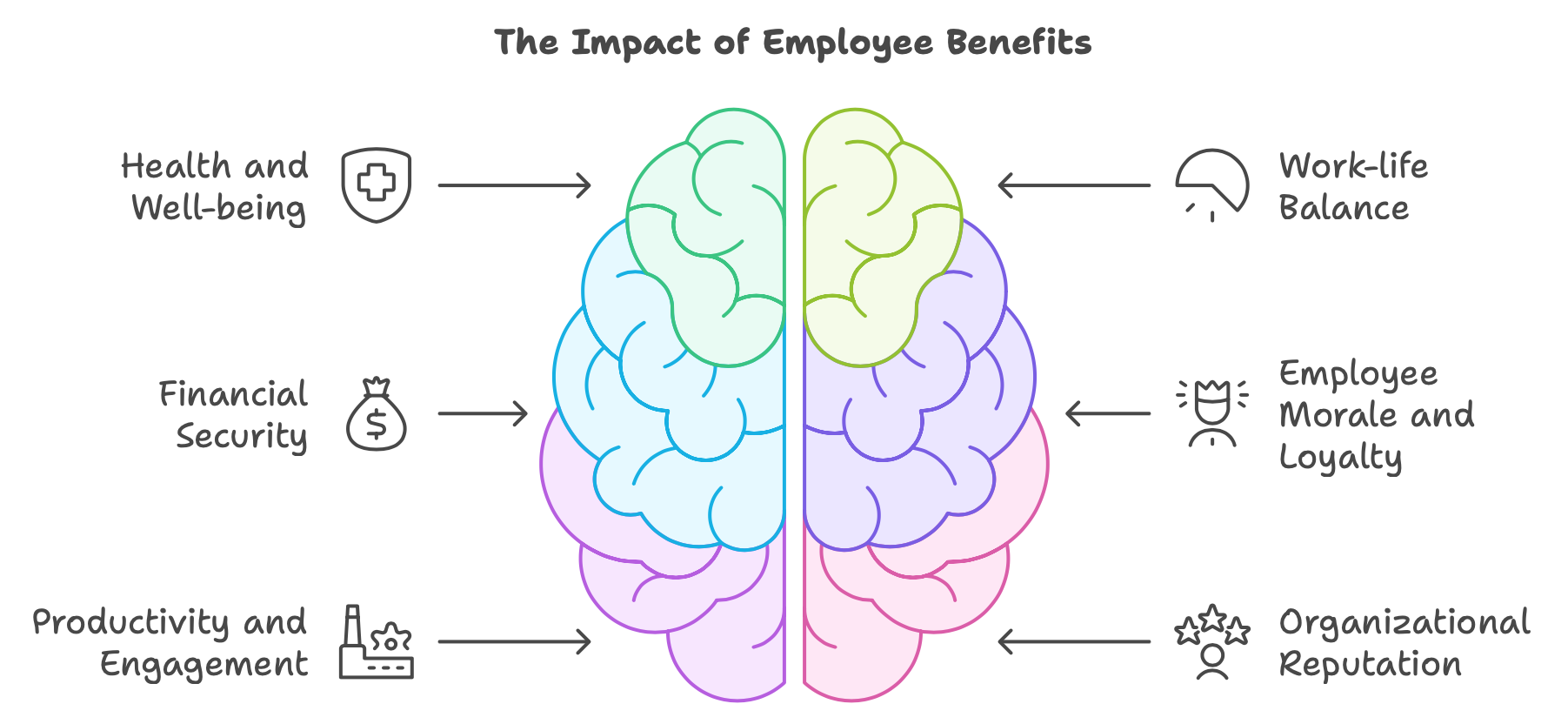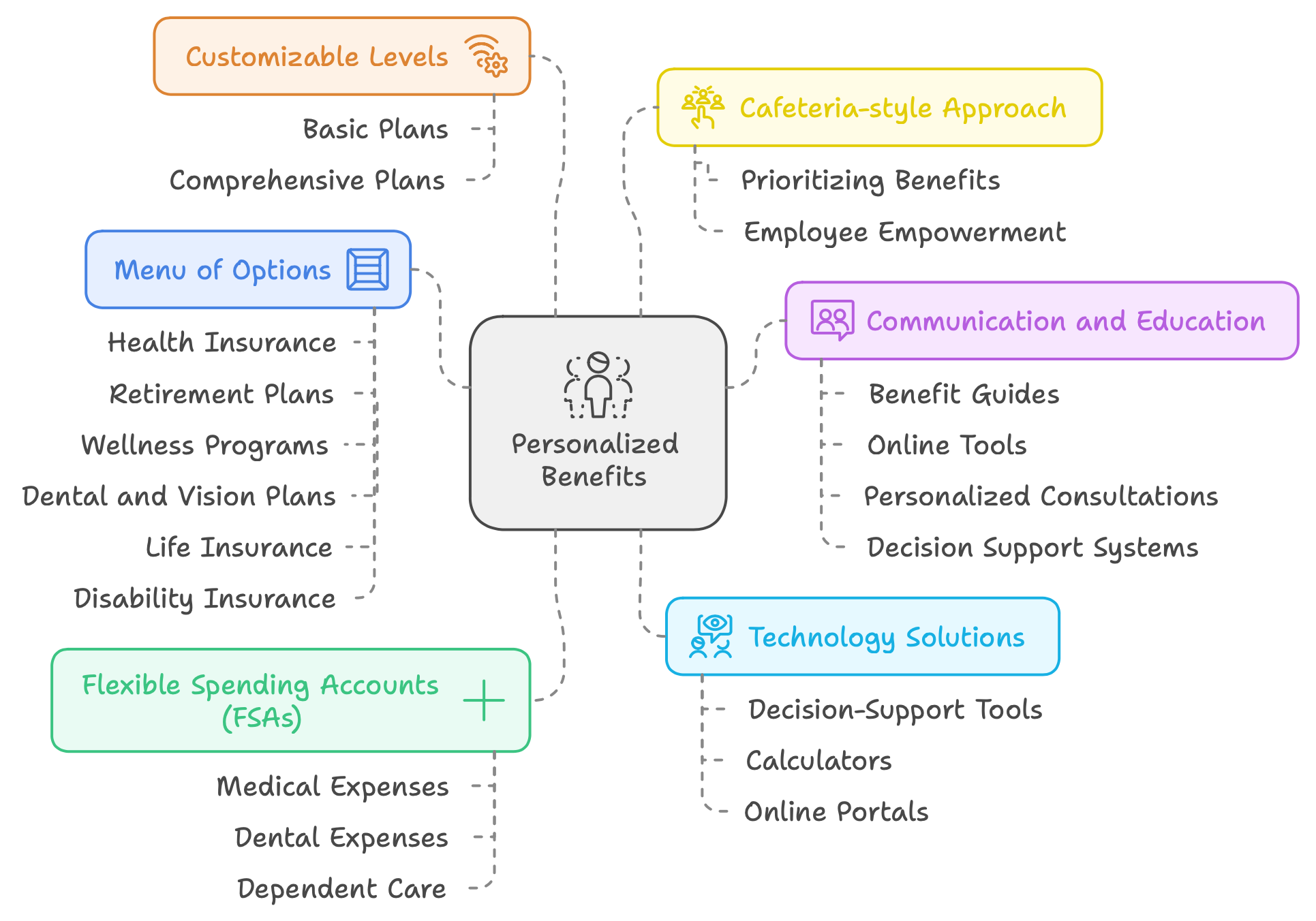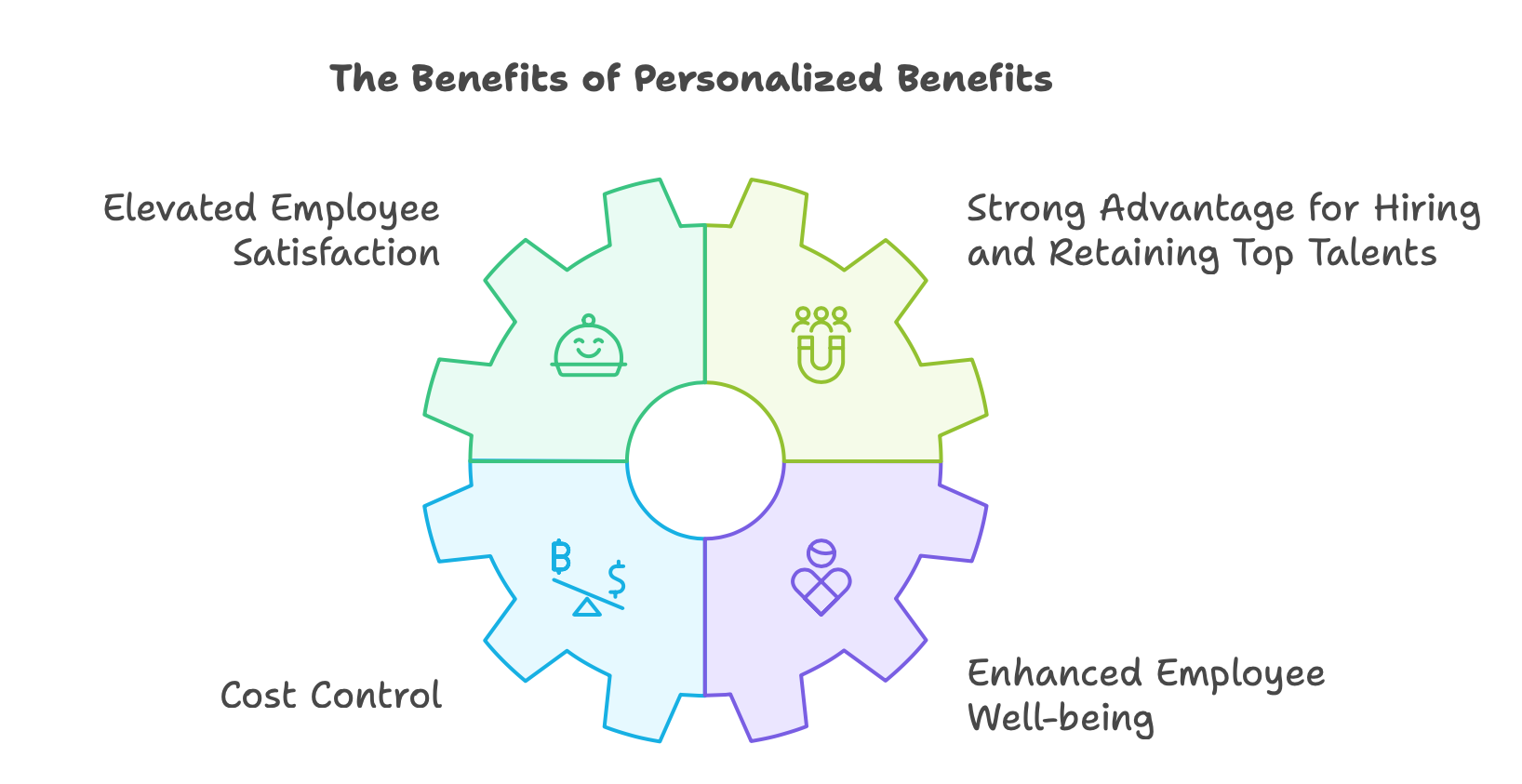Customized Benefits for Employee Satisfaction: The Power of Personalization
Employee benefits play a crucial role in shaping the overall experience of employees within an organization. From health insurance to work-life balance initiatives, these benefits, much like People Strategy Consulting, can significantly impact employee satisfaction, engagement, and retention.
Employee benefits are closely connected to a company's values as they reflect the organization's commitment to its employees' well-being, satisfaction, and overall experience.
Companies that prioritize their employees' needs and satisfaction as a core value often design and offer comprehensive employee benefits. By providing benefits that address employees' health, work-life balance, financial security, and personal development, demonstrating its commitment to its people.
Employee benefits are closely connected to a company's values as they reflect the organization's commitment to its employees' well-being, satisfaction, and overall experience.
Companies that prioritize their employees' needs and satisfaction as a core value often design and offer comprehensive employee benefits. By providing benefits that address employees' health, work-life balance, financial security, and personal development, demonstrating its commitment to its people.

Standard Benefits Most of the Businesses offer
Here are some key points highlighting the impact of employee benefits on the overall employee experience:
Attracting and retaining top talent: In a competitive job market, offering attractive employee benefits is essential for attracting and retaining high-quality employees. Candidates often consider the benefits package as a significant factor when evaluating potential job opportunities. Companies that provide comprehensive benefits are more likely to attract and retain talented individuals.
Health and well-being: Health insurance is one of the most critical benefits provided by organizations. Access to quality healthcare coverage can enhance the overall well-being of employees and their families. It provides a sense of security, reduces financial stress related to medical expenses, and promotes a healthier workforce. Additionally, wellness programs, such as gym memberships, mental health support, and preventive health initiatives, can further contribute to employee well-being.
Work-life balance: Employee benefits that support work-life balance, such as flexible work hours, remote work options, and generous paid time off, can greatly improve employee satisfaction. These benefits empower employees to manage their personal and professional lives more effectively, resulting in increased productivity, reduced stress, and improved morale. Achieving a healthy work-life balance helps employees feel valued, leading to higher job satisfaction and lower burnout rates.
Financial security: Benefits that promote financial security, such as retirement plans, stock options, and financial counseling services, are highly valued by employees. These benefits demonstrate the employer's commitment to the long-term financial well-being of their workforce. By helping employees save for the future and providing resources to manage their finances, organizations can alleviate financial stress and increase employee loyalty and engagement.
Employee morale and loyalty: When employees feel that their employer genuinely cares about their well-being, it fosters a positive work environment and enhances overall morale. Offering a comprehensive benefits package sends a message that the organization values its employees, leading to increased loyalty, job satisfaction, and a sense of belonging. Employees who feel supported and appreciated are more likely to be engaged, productive, and committed to the company's success.
Productivity and engagement: Employee benefits can have a direct impact on productivity and engagement levels. When employees have access to benefits that address their needs and priorities, they are more likely to feel motivated and engaged in their work. Improved well-being, work-life balance, and financial security lead to higher levels of job satisfaction, which, in turn, can boost productivity, creativity, and overall performance.
Organizational reputation: A strong employee benefits program can significantly contribute to an organization's reputation as an employer of choice. Positive word-of-mouth from satisfied employees can attract top talent, while a negative reputation can hinder recruitment efforts. A robust benefits package that meets the evolving needs of employees enhances the organization's brand and can serve as a competitive advantage in the job market.
In summary, employee benefits have a profound impact on the overall employee experience. They not only attract and retain top talent but also contribute to employee well-being, work-life balance, financial security, and job satisfaction. By investing in comprehensive benefits programs, organizations can create a positive work environment, boost employee morale and engagement, and ultimately drive their own success.
Attracting and retaining top talent: In a competitive job market, offering attractive employee benefits is essential for attracting and retaining high-quality employees. Candidates often consider the benefits package as a significant factor when evaluating potential job opportunities. Companies that provide comprehensive benefits are more likely to attract and retain talented individuals.
Health and well-being: Health insurance is one of the most critical benefits provided by organizations. Access to quality healthcare coverage can enhance the overall well-being of employees and their families. It provides a sense of security, reduces financial stress related to medical expenses, and promotes a healthier workforce. Additionally, wellness programs, such as gym memberships, mental health support, and preventive health initiatives, can further contribute to employee well-being.
Work-life balance: Employee benefits that support work-life balance, such as flexible work hours, remote work options, and generous paid time off, can greatly improve employee satisfaction. These benefits empower employees to manage their personal and professional lives more effectively, resulting in increased productivity, reduced stress, and improved morale. Achieving a healthy work-life balance helps employees feel valued, leading to higher job satisfaction and lower burnout rates.
Financial security: Benefits that promote financial security, such as retirement plans, stock options, and financial counseling services, are highly valued by employees. These benefits demonstrate the employer's commitment to the long-term financial well-being of their workforce. By helping employees save for the future and providing resources to manage their finances, organizations can alleviate financial stress and increase employee loyalty and engagement.
Employee morale and loyalty: When employees feel that their employer genuinely cares about their well-being, it fosters a positive work environment and enhances overall morale. Offering a comprehensive benefits package sends a message that the organization values its employees, leading to increased loyalty, job satisfaction, and a sense of belonging. Employees who feel supported and appreciated are more likely to be engaged, productive, and committed to the company's success.
Productivity and engagement: Employee benefits can have a direct impact on productivity and engagement levels. When employees have access to benefits that address their needs and priorities, they are more likely to feel motivated and engaged in their work. Improved well-being, work-life balance, and financial security lead to higher levels of job satisfaction, which, in turn, can boost productivity, creativity, and overall performance.
Organizational reputation: A strong employee benefits program can significantly contribute to an organization's reputation as an employer of choice. Positive word-of-mouth from satisfied employees can attract top talent, while a negative reputation can hinder recruitment efforts. A robust benefits package that meets the evolving needs of employees enhances the organization's brand and can serve as a competitive advantage in the job market.
In summary, employee benefits have a profound impact on the overall employee experience. They not only attract and retain top talent but also contribute to employee well-being, work-life balance, financial security, and job satisfaction. By investing in comprehensive benefits programs, organizations can create a positive work environment, boost employee morale and engagement, and ultimately drive their own success.
Personalized Benefits and their impact
Personalized benefits, also known as employee choice programs or flexible benefits, allow employees to select and customize their benefits package based on their individual needs and preferences. This approach recognizes that employees have unique circumstances and priorities, and aims to provide them with a more tailored and meaningful benefits experience. Here's a closer look at personalized benefits:

Menu of Options: Instead of a one-size-fits-all benefits package, employers offer a range of benefit options from which employees can choose. These options may include different levels of health insurance coverage, retirement plans, wellness programs, dental and vision plans, life insurance, disability insurance, and more.
Flexible Spending Accounts (FSAs): FSAs are often a key component of personalized benefits. They allow employees to set aside a portion of their pre-tax income to cover qualified expenses such as medical, dental, or dependent care. Employees can decide how much to contribute to their FSA based on their anticipated needs.
Customizable Levels: In addition to choosing from a menu of benefit options, employees may have the ability to select different coverage levels or tiers within each benefit category. For example, they might choose between basic and comprehensive health insurance plans, or select different levels of retirement plan contributions.
Cafeteria-style Approach: The concept of a "benefits cafeteria" is often used to describe personalized benefits. It's akin to choosing items from a cafeteria buffet, where employees can pick and choose the benefits that best suit their needs. This approach empowers employees to prioritize benefits that are most important to them.
Communication and Education: Employers must provide clear and comprehensive communication and education to ensure employees understand their benefit options and how to make informed decisions. This can include benefit guides, online tools, personalized consultations, and interactive decision support systems.
Technology Solutions: Many companies leverage technology platforms to facilitate personalized benefits enrollment and management. These platforms often include decision-support tools, calculators, and online portals that allow employees to explore different benefit options, estimate costs, and make selections.
The Benefits of the Personalized Benefits

How Personalized Benefits Drive Competitive Talent Acquisition
In my experience, offering personalized benefits when hiring top candidates has been a game-changer. When candidates can tailor their benefits package—choosing options that suit their unique needs—it creates a sense of ownership and satisfaction.
I’ve noticed that high-caliber professionals, especially those in competitive markets, deeply value this flexibility. It shows that the company genuinely cares about their well-being, which not only makes the offer more attractive but also fosters loyalty from the start.
This level of personalization sets your company apart and helps secure the best talent.
I’ve noticed that high-caliber professionals, especially those in competitive markets, deeply value this flexibility. It shows that the company genuinely cares about their well-being, which not only makes the offer more attractive but also fosters loyalty from the start.
This level of personalization sets your company apart and helps secure the best talent.
and Talent Management
Increased Employee Satisfaction: Personalized benefits demonstrate that the organization values and respects the individual needs and preferences of its employees. This can lead to higher levels of employee satisfaction, engagement, and loyalty.
Improved Retention and Attraction: Offering personalized benefits can differentiate an employer from competitors and attract top talent. It allows companies to cater to the diverse needs of a multigenerational workforce and provides a competitive advantage in the job market.
Cost Control: While personalized benefits require additional administrative efforts, they can also help manage costs. By allowing employees to choose the benefits they value most, employers can align their benefit spend with employee preferences and reduce the likelihood of providing benefits that go unused or unappreciated.
Enhanced Employee Well-being: Personalized benefits enable employees to access the benefits that directly address their well-being needs. This can include options like mental health resources, flexible work arrangements, wellness programs, or financial assistance, leading to improved overall well-being.
Implementing personalized benefits requires thoughtful planning, effective communication, and robust technology solutions. Employers should consider partnering with benefits consultants from UnitiQ which helps to develop and implement benefits based on the best specialized platforms to streamline the enrollment process and ensure employees can easily navigate and select their personalized benefits.
When employee benefits are aligned with company values, they become a tangible demonstration of the organization's culture and its commitment to creating a positive work environment. Such alignment fosters employee engagement, loyalty, and satisfaction, ultimately contributing to the overall success of the company.
UnitiQ: Combining Personalized Benefits and Employer Branding to Attract Top Talent
UnitiQ helps businesses attract top talent by combining personalized benefits with a strong employer brand. By offering flexible, tailored benefits packages, UnitiQ ensures that candidates feel valued and supported, creating a competitive edge in the hiring process.
This personalized approach, paired with a clear company story and mission, strengthens the employer brand, making your company stand out to high-caliber professionals.
Through this strategy, UnitiQ enables businesses to connect with and secure the right candidates who align with both the company’s goals and culture.
We are happy to help you with Talent Acquisition and HR tasks, please contact me, Olga Fedoseeva, Fonder at UnitiQ, directly:
My Telegram
My LinkedIn
This personalized approach, paired with a clear company story and mission, strengthens the employer brand, making your company stand out to high-caliber professionals.
Through this strategy, UnitiQ enables businesses to connect with and secure the right candidates who align with both the company’s goals and culture.
We are happy to help you with Talent Acquisition and HR tasks, please contact me, Olga Fedoseeva, Fonder at UnitiQ, directly:
My Telegram
My LinkedIn
